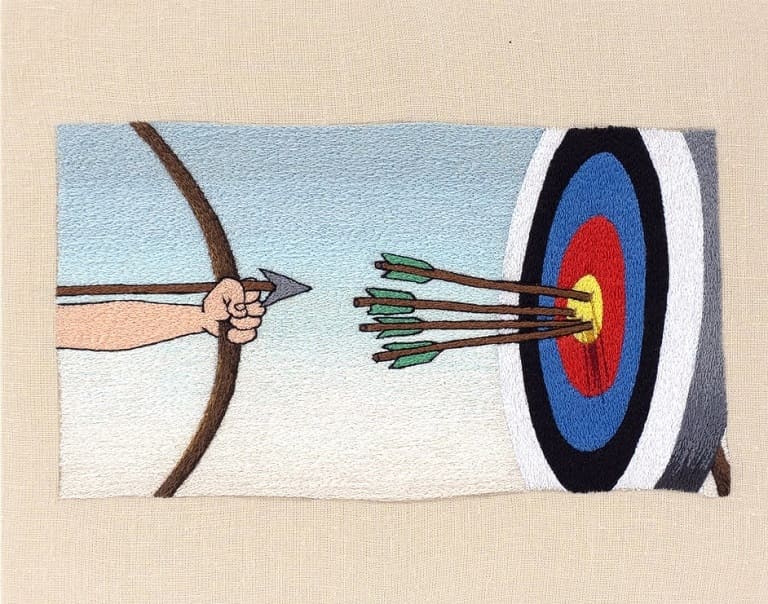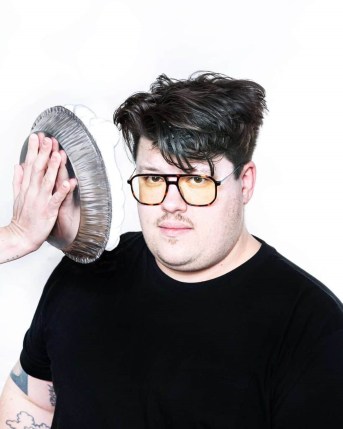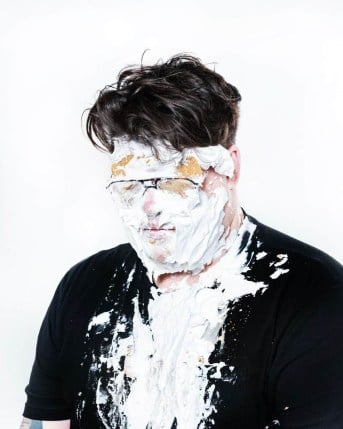Interview
Stitching Stories: Interview with Textile Artist Peter Frederiksen

Interview by Adam Hencz
With thread and needle, Peter Frederiksen defies convention and elevates embroidery to an art form. Inspired by classic cartoons such as Looney Tunes and The Simpsons, Frederiksen’s creations feature intricate embroidery on linen canvas stretched onto wooden panels.
His unique textile art uses a standard sewing machine in a free-motion style, resulting in a dense, hypnotic effect. Frederiksen carefully curates screenshots from old cartoons, editing and cropping them to create a compelling narrative. His art delves into the violent moments in cartoons, capturing knives piercing doors and hands contorting while playing the piano.
With his upcoming exhibition titled Coward!, Frederiksen explores the human experience of fear and failure. He questions the success of his previous works, asking himself whether people appreciate his art for the imagery or the threads he is pulling at. The exhibition includes 19 new works, with three larger pieces featuring embroideries on jacquard weavings, breaking new ground in his medium. The titular piece stands out, a blank canvas with the word Coward! painted in cursive, casting a shadow over a newly-set sun.
In Conversation with Peter Frederiksen
In our interview, Frederiksen opens up about his creative process and questions whether he is brave enough to explore new territories. Yet his dedication to his craft shines through, and his unique approach to embroidery is here to inspire those who appreciate the art of storytelling – through the thread.
Can you share a specific moment or scene from that first cartoon that stands out in your memory? How did it influence you?
Like so many, I grew up with Looney Tunes as a Saturday morning staple. My father and my brother, and I would watch, my father in his tattered robe with his coffee, and my brother and I with our sugary cereal. My memories are more of this than of the cartoons, specifically, but if I had to pick one out, of course, I remember the pinnacle: What’s Opera, Doc?, the Fantasia-spoofing Wagner opera between Bugs Bunny and Elmer Fudd. I probably remember it most because I’m sure it was the most popular. The ways in which I have been inspired by these Saturday mornings are so deeply-rooted that I am positive that it’s no longer influence but foundational.


How do you go about selecting the specific details and scenes from cartoons that you use in your work?
Sometimes it starts as an idea that I then research and find imagery for, and other times it comes about from just watching episodes of Looney Tunes and responding to images or ideas. My compositions all start as collections of screenshots, compiled to make whatever scene I’m trying to depict. Usually, there’s some heavy cropping happening, focusing on small details.
Your ongoing exhibition at The Flat is titled Coward! and it explores themes like the fear of losing, suspense, anxiety, and violence. Why do you think it is important to highlight these feelings in your work?
We’re living in interesting times! I wake up in the morning every day to news alerts on my phone about the terrible things that happened in the last 24 hours across the globe. My anxieties about the state of things permeate my waking thoughts. Fortunately, I don’t really dream. Hahaha.
Putting these anxieties into art helps me to understand why I think about them and why they’re important to me. Through the lens of 80-year-old cartoons, they don’t feel so profound or new – we’re dealing with a lot of the same shit that has been circling for generations. They’re silly, but they’re also not going anywhere, which can be depressing. Ultimately, we’re right to worry about violence and global warming, and the well-being of our fellow humans. It’s essential to being human, worrying. Fearing. It’s animal, but we learn from it.
Can you share the meaning behind the recurring characters or motifs (like traps, axes, trees) you use in your embroideries?
Metaphors call for repetition. Throughout the show, there are six pieces showing trees in different stages of being chopped down. I wanted to emphasize this as work that had been started but unfinished, similar to my self-reflection. Some of the trees are standing tall despite the actions taken against them; some trees appear to be teetering, close to falling over; one tree defies gravity altogether. These trees are denied growth and purpose at once, perpetually stuck in transition.
Then there’s the other tree, shown in the only black-and-white image titled Forging a path. showing a sort of shortcut. What could have been either a left or a right is presented as something else; here, the tree which may have started as an obstacle is shown to be surmountable, should one only be able to ignore our laws of physics. Another defiance of growth, but in a much more childish manner: by making my own rules, I control the game.
Guaranteeing an outcome is another recurring motif, shown in I know what I’m doing, I’ve played this game before, and Going easy on myself. More of the same, really, but these are about the prevention of growth through an insistence on winning. When a game becomes about an outcome, you risk losing perspective.
Why did you choose the free-motion machine technique as your primary method of creation? Do you work with other methods besides “drawing with the sewing machine”?
I’ve been drawn to fiber artwork for a long time now, and free-motion machine embroidery is a very efficient way to make the kinds of images I want to be making. Once upon a time, I did hand embroidery, and my wrist will likely make a clicking noise for the rest of my life thanks to hand embroidery. Hahaha. I used to paint, I used to draw. I still love those methods of expression, but machine embroidery excites me. In the same vein, I’m excited to continue experimenting with fiber sculpture and digital-focused work like jacquard.
Can you tell us about a particularly challenging piece or series you’ve worked on and how you overcame the obstacles during the process?
Hahaha, I think every series is challenging until it’s done. Like with Coward! and the one work acting as a sort of Rosetta Stone for me, each body of work I make is sweat, blood, and tears until I get to a place where I view it as a whole. Getting distance from a series is essential for me, both figuratively and literally. I find that it’s really helpful to take small photographs of the works and view them together on one screen. A new perspective.
You’re currently also a partner and producer at RAD Represents, an agency representing commercial artists. Can you tell us about RAD Represents and some of the projects, artists, and brands you and the agency have worked with?
My day job! I work with commercial photographers, directors, illustrators, animators, and everything in between to make ads. I started working in ad agencies like 12 years ago, first as an office handyman and then (through, essentially, luck) as a producer. I worked in agencies for a long time, and when I broke out, I was lucky (again) to be able to join forces with one of my best friends, Andrea, who had an artist representation company that she owned and operated. Working for yourself with one of your best friends is the dream.
We represent a small roster of artists, producing work for whoever will hire us. We recently did a whole mess of work for Jell-O!
Artificial intelligence is all over the news these days. Its impact on creativity and productivity is a controversial topic in the art world. Have you experimented with AI art? How do you see AI impacting the life of artists and the creative process?
I’ve not experimented with AI yet, but I’m not against the idea! I’ve seen some very basic conversation surrounding the aping and appropriation of specific styles of art and specific artworks for things like AI portrait apps, and, like, I see why this is bothering people, I guess, but I just do not care. I hope that collectors go nuts for AI artworks. I see this as growth. Embracing new tech is great. If any artist can make a killing on it, go for it. Make some more bored apes or something. Pay it forward, tho. Sell art, buy art.
How do you see your work evolving in the future, and what new themes or mediums do you hope to explore?
I’ve been working a lot on embroidery into jacquard weaving, attempting to marry the digital and the physical a little more. Old tech meets new tech, that kinda thing. I’m working on the largest work I’ve ever made (the largest by a lot), and it’ll probably take a few more weeks to get it to a good place, but I’m excited to try something BIG. My work is so small, so this feels very different for me. I’ve got two more solo shows this year, so I’ve got my work cut out for me.
Peter Frederiksen works and lives in Chicago. He attended the School of the Art Institute of Chicago, studying painting, drawing, and fibers before working at ad agencies as an art producer. He is now a partner, representative, and producer at RAD Represents, an artist representation company while taking part in the bustling art scene in Chicago.
Relevant sources to learn more
COWARD! by artist Peter Frederiksen at The Flat – Massimo Carasi
Discover and buy art by artist Peter Frederiksen
Visit the artist’s website
Read more articles from Artland Magazine
Embroidery Art: 9 Artists Pushing the Boundaries of Contemporary Art with Needle and Stitch
Wondering where to start?


